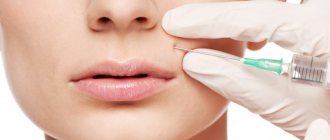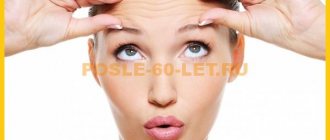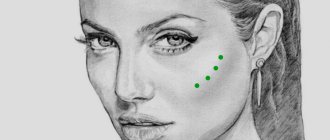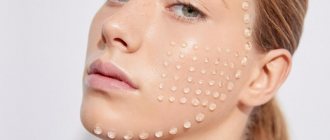WHAT ARE BEAUTY INJECTIONS FOR, HOW THEY WORK AND WHEN TO USE THEM
Injection cosmetology (popularly “beauty injections”) is a branch of aesthetic medicine and an integral part of modern methods of rejuvenation and prevention of aging.
The use of injection techniques is aimed at solving a variety of problems: smoothing wrinkles and folds, replenishing missing volumes and providing a lifting effect, correcting facial asymmetry, improving the quality and color of the skin, reducing pigmentation, pathological vascular network and the severity of acne, restoring the water-lipid mantle of the skin.
Of course, it is very difficult to understand the indications for injection procedures and at what age to carry them out, especially if you are still very young and it seems that it is too early to resort to such serious procedures. It is important to note that injections, like any cosmetic procedures in principle, should not be done in accordance with any age categories, but solely according to indications!
In the case of injection techniques, everything is too individual!!!
Biorevitalization
The word itself comes from the Latin “bio” (life) and “revitalization” (restoration). In a general sense, biorevitalization includes all rejuvenation techniques that, through subcutaneous or intradermal administration of biologically active substances, improve the condition of the extracellular matrix.
These are preparations based either on hyaluronic acid alone , or its combination with vitamins, minerals, amino acids, plant extracts - in this case the method is usually called bioreparation.
The effect of biorevitalization
The magic of hyaluronic acid lies in its ability to attract and retain water due to its large molecular weight. Its huge role in moisturizing the skin has already been scientifically proven. Thanks to this property, preparations based on “hyaluronic acid” saturate the skin with moisture, making it more protected from the effects of aggressive environmental factors and microorganisms, giving it elasticity and a healthy appearance.
In addition, bioremedies act on fibroblasts, activating intracellular processes, accelerating the production of collagen, elastin and its own hyaluronic acid.
EVENTUALLY:
The skin is evened out and its elasticity increases. The complexion improves, age spots and wrinkles become less noticeable or disappear altogether, and stretch marks are reduced.
When to start biorevitalization procedures
Injections of biorevitalizants are used for visible rejuvenation of the skin of the face, neck and décolleté, hands and any other parts of the body that the patient wants to “revive”.
This is one of the most effective methods for preventing photoaging and restoring the hydrolipid mantle of the skin after exposure to the sun or after a frosty winter, etc.
The very first manifestation of age-related changes is the loss of moisture in the skin. This process is associated both with the failure of protective barriers and with a physiological age-related decrease in the synthesis of hyaluronic acid. In the first stages, we can only cope with external means, depending on our genetic characteristics, but only up to the age of 30. Then, starting at the age of 35, the moment comes when we need to start “preventing” aging. Yes, that’s right: by starting to work with the skin on time and regularly – by “biorevitalizing” it at least 2 times a year – you can significantly slow down all age-related changes .
General clinical recommendations for patients with gouty arthritis
All patients suffering from gout are advised to:
- follow a diet, lead an active lifestyle;
- follow all doctor's orders, including taking prescribed urate-lowering medications;
- monitor your weight;
- treat concomitant diseases: diabetes, obesity, angina pectoris, high blood pressure, chronic kidney disease.
Prevention of gout
Gout is most often associated with hereditary metabolic characteristics. There are also no factors predisposing to the development of this disease. If you eliminate their influence, then even if you have a family history, you can significantly reduce the risk of developing the disease. To do this, you need to follow the following recommendations:
- do not overeat, reduce the calorie content of your daily diet, do not consume offal, red meat, alcohol, quit smoking;
- get rid of excess weight;
- Take any medications in consultation with your doctor - some of them increase the concentration of uric acid (diuretics, nicotine, acetylsalicylic acid, etc.);
- regularly treat chronic diseases: diabetes, obesity, kidney and cardiovascular diseases;
- men over 40 years old, and women over 50, periodically check the level of uric acid in the blood.
How long does the effect of biorevitalization last?
Hyaluronic acid deposited in the skin breaks down naturally and is excreted from the body, so the result after a course of procedures of three injections lasts on average 4-6 months. Moreover, this period depends not only on the drug, but also on the individual characteristics of the body and lifestyle - smoking, sun rays, ultrasonic waves, etc. accelerate the breakdown of hyaluronic acid. In addition, new generation drugs, for example, Profhilo biorevitalization, provide hydration for up to 6 months after a double procedure. The same technique can be used for the neck, décolleté and hands.
Approach to the treatment of gouty arthritis at the Paramita clinic
Our clinic has developed a unique method for treating gouty arthritis. There are two opposing approaches to identifying and treating this disease. First of all, a thorough clinical, laboratory and instrumental examination of the patient is carried out. After establishing the final diagnosis and concomitant diseases, individually selected comprehensive treatment is prescribed, including:
- modern Western techniques, including the use of the latest medications; this allows you to eliminate inflammation and pain during a gout attack and maintain the desired level of uric acid in the blood serum during the inter-attack period;
- traditional oriental techniques that have a regulating effect on the body as a whole and on the site of inflammation; techniques allow you to eliminate pain after the first session; After the course of treatment, the patient feels a surge of strength and complete renewal.
We combine proven techniques of the East and innovative methods of Western medicine.
Read more about our unique method of treating arthritis
A completed course of treatment and properly selected urate-lowering therapy allows the patient to forget about gout attacks for a long time (in most cases until the end of life). You can get more detailed information about treatment at the clinic on our website.
Botox injections
How they work
Botox under different brands - Dysport® (AbobotulinumtoxinA), Botox® (OnabotulinumtoxinA), Xeomin® (IncobotulinumtoxinA), RELATOX® (Botulinum toxin type A complexed with hemagglutinin) - contains purified and weakened botulinum toxin, which blocks the nerve signal and, as it were, freezes muscles. As a result, some wrinkles are softened or completely smoothed out.
The method is effective only for eliminating expression wrinkles, that is, those that form as a result of facial activity on the forehead, between the eyebrows, at the base of the nose and in the corners of the eyes. Such injections are not always able to remove wrinkles and folds caused by tissue sagging.
How does mesotherapy work?
The active ingredients can be different: from vascular protectors and other registered drugs to vitamins, microelements, lipolytics and plant extracts, for example, artichoke extract. Often hyaluronic acid is also present in cosmetic meso-cocktails, but this is not a necessary component.
Hence the various effects and wide scope of application. Each component of the solution has a different effect on skin tissue. For example, during lipotherapy, lipolytics destroy the membrane of fat cells, accelerate lipolysis - the breakdown of fats - and even out the structure of the skin through collagen synthesis.
Indications and when to start doing mesotherapy
Due to the diversity of the composition of drugs, mesotherapy in cosmetology is used:
- to rejuvenate the skin and improve its quality;
- in the treatment of acne, correction of pigmentation, stabilization of the vascular wall;
- to combat alopecia;
- during lipomodelling, when you need to remove excess fat and shape the contours of the face and body;
- in the complex correction of stretch marks.
The dermatologist selects the dosage and drug or their combination, focusing on the problem. There are no ready-made solutions.
Starting from adulthood, if you have the above problems, you can start doing mesotherapy procedures.
General information about the disease
Gouty arthritis is a systemic metabolic disease associated with the deposition of uric acid salts in articular and periarticular tissues. Men get sick more often after 40 years of age. In women, gout is less common and begins later - in the postmenopausal period after 50-60 years. In total, gout affects about 2.5% of these populations. With age, this percentage increases significantly and by the age of 80 it is 9% in men and 6% in women. The ICD-10 code is M10.
Gouty arthritis is comorbid (often combined) with kidney diseases and chronic renal failure, cardiovascular diseases (angina pectoris, high blood pressure), type 2 diabetes mellitus, and obesity.
Despite the fact that treatment for this disease has been developed, it is not always possible to keep gout attacks under control. This mainly occurs due to patients’ misunderstanding of the mechanism of development (pathogenesis) of gout and refusal or irregular maintenance therapy.
Read more about arthritis, its symptoms and treatment in this article.
Contour plastic surgery - injection of fillers
Contour plastic surgery is the introduction of drugs called fillers into the problem area. Fillers are ready-made fillers in the form of gels of varying degrees of viscosity, of natural or synthetic origin, which in many cases can replace surgical plastic surgery. At the same time, the techniques for introducing fillers into the skin can be very different: with a microneedle directly under the wrinkle, using a thin guide - a cannula, or the vector lifting technique.
When it helps
Thanks to skillful injections, you can tighten the oval of the face, hide nasolabial folds or remove bags under the eyes, restore the volume of the lips and correct their asymmetry, eliminate jowls, raise the corners of the eyebrows for a more expressive look, and lift the corners of the lips, which droop down with age. With the help of fillers, you can even correct the shape of the nose or chin, “remove” fine wrinkles in the cheek area and, in addition, significantly improve the quality of the skin.
It is important to understand that it is impossible to choose such a drug in absentia. They differ in composition, viscosity and concentration of hyaluronic acid, as well as the presence of other active ingredients. The dermatologist selects the right drug and the option for its administration based on many factors: the general condition of the skin, the severity and depth of wrinkles and their location, the anatomical structure of the face, age and tendency to allergies.
How does it work
As adipose tissue decreases, the skin loses elasticity and sags. Fillers fill these voids and folds, thus smoothing out wrinkles, strengthening and improving the tissue structure. The active composition varies:
- Hyaluronic acid. The safest filler, since a similar substance is produced in our body. Hyaluronic acid retains moisture and stimulates the production of your own collagen and elastin. Another plus is that the result is reversible. So asymmetry or too voluminous lips can be corrected: the doctor will simply inject hyaluronidase, which quickly breaks down the hyaluronic acid.
- Collagen. There are two varieties: synthetic and animal origin. The main advantage of this filler is that the face looks natural after such plastic surgery.
- Poly-L-lactic acid (preparation AestheFill ) is a biocompatible synthetic substance. The filler stimulates the synthesis of its own collagen, due to which a pronounced rejuvenating effect is manifested. The result is not noticeable immediately, but after a course of injections - after 2 months, with a gradual increase in the effect.
How long does the effect last?
Biodegradable fillers last the least. Thus, collagen of animal origin begins to disintegrate within a month and the result, accordingly, disappears.
Hyaluronic acid injections will have to be repeated after an average of 6–9 months. Fillers with poly-L-lactic acid - up to 12-14 months.
Fillers can go by a variety of names. However, it is not the brand that is more important, but understanding what kind of filler you need.
When to start doing
In relation to contour plastic surgery, this is a rhetorical question, since the goals, objectives and possibilities of the technique are quite wide: that is, according to the presence of aesthetic defects or as they appear, but not earlier than from the age of 18.
Side effects
In the hands of a professional, side effects from contour plastic surgery performed with high-quality certified drugs occur extremely rarely. In addition to an allergic reaction, which more often occurs with fillers of animal origin, hypercorrection syndrome may “manifest.” In this case, the drug Hyaluronidase is administered, an enzyme that dissolves hyaluronic acid.
Cause and mechanism of development (etiology and pathogenesis) of the disease
The cause of gouty arthritis is a disorder of purine metabolism. Purines are chemical compounds that form the basis of nucleic acids necessary for the formation of DNA and RNA molecules. As cells break down, purines are broken down into uric acid (UA). The latter enters the intercellular space and into the blood plasma, where it combines with sodium, forming a salt - monosodium urate (MUN).
An increased level of urate in the blood (hyperuricemia - GU) may be a consequence of a genetic predisposition (the kidneys do not eliminate MUN completely), high blood pressure (BP), consumption of large amounts of animal food, and alcohol.
With an excess of urates, when they can no longer dissolve in the surrounding fluid (EOR concentration more than 0.4 mmol/l), the salts crystallize, deposit in the articular and periarticular tissues and are surrounded by protein rings. This formation is called tophi. The release of MUN from the tophi causes an immunological reaction: a large number of neutrophils (one of the types of leukocytes responsible for cellular immunity) appear in the synovial membrane and joint fluid.
Neutrophils ingest MUN crystals, which causes the release of proinflammatory (inflammation-causing and maintaining inflammation) cytokines and the development of an acute inflammatory response in the synovium. Acute attacks in the form of synovitis are very painful, but do not leave any consequences. The long-term chronic course of the disease with frequent repeated attacks leads to the destruction of articular cartilage, proliferation of bone tissue, deformation and dysfunction of the joint. Deposition of MUN in the kidneys causes a decrease in their function.
Factors contributing to increased urate levels in the blood:
- the presence in the diet of a large number of meat dishes, offal, eggs, alcoholic beverages,
- overweight;
- taking certain medications - diuretics, aspirin, nicotinic acid, medications to lower blood pressure (Concor), etc.;
- lead poisoning;
- increased breakdown of purines in blood diseases, psoriasis, etc.;
- increased formation of purines;
- impaired renal function and uric acid excretion.
Plasma therapy
Plasma therapy is positioned as a natural healing of the skin and more. Instead of drugs, the patient’s own plasma is used here, processed in a special way and enriched with platelet-derived growth factors. Plasma therapy is also called plasma lifting or PRP therapy - all these are synonyms.
How does it work
Plasma enriched with growth factors helps remove cell components destroyed by photoaging, activates fibroblasts that produce collagen, improves and renews skin tissue.
Multiple studies confirm the results: smooth texture and tone of the face, less noticeable wrinkles and stretch marks, a slight lifting effect.
When it helps
In aesthetic medicine, plasma therapy is recommended to be used:
- for aging skin, as plasma lifting improves relief and color, relieves swelling, reduces wrinkles;
- in the treatment of acne and post-acne, atopic dermatitis and eczema;
- when restoring skin after aggressive procedures.
Plasma therapy is often used in combination with other techniques, such as fillers, chemical peels or laser procedures. This is how PRP helps the skin recover faster after procedures.
How long does the effect last?
According to scientific research, the results of PRP therapy appear faster and last longer in younger patients - up to 35 years. For such people, it is enough to repeat the injections after 12–24 months.
Side effects
If the conditions for plasma therapy are strictly observed (taking blood on an empty stomach, no exacerbations of herpes infection for a month, etc.), there is usually no adverse reaction.
Frequently asked questions about the disease
Is it possible to get disability?
For chronic tophi gouty arthritis with impaired joint function.
Which doctor treats you?
Rheumatologist.
What prognosis do doctors usually give?
With proper systematic treatment under the supervision of a physician, the prognosis is favorable.
Gouty arthritis requires constant monitoring by a rheumatologist, urate-lowering therapy, diet and all doctor’s recommendations. If treated correctly, you can forget about gout attacks forever. Doctors at the Paramita clinic have extensive experience in treating gout. Contact us!
Literature:
- Fedorova A. A., Barskova V. G., Yakunina I. A., Nasonova V. A. Short-term use of glucocorticoids in patients with prolonged and chronic gouty arthritis. Part III. Frequency of development of adverse reactions // Scientific and practical rheumatology. 2009; No. 2. pp. 38–42.
- Eliseev M. S. Gout. In the book: Russian clinical guidelines. Rheumatology / Ed. E. L. Nasonova. M.: GEOTAR-Media, 2022. pp. 372–385.
- Rainer TH, Cheng CH, Janssens HJ, Man CY, Tam LS, Choi YF Oral prednisolone in the treatment of acute gout: a pragmatic, multicenter, double-blind, randomized trial // Ann Intern Med. 2016; 164(7):464–471.
- Reinders M., van Roon E., Jansen T., Delsing J., Griep E., Hoekstra M. et al. Efficacy and tolerability of urate-lowering drugs in gout: a randomized controlled trial of benzbromarone versus probenecid after failure of allopurinol // Ann Rheum Dis. 2009; 68:51–56.
Themes
Arthritis, Joints, Pain, Treatment without surgery Date of publication: 01/25/2021 Date of update: 02/02/2021
Reader rating
Rating: 4.57 / 5 (14)










